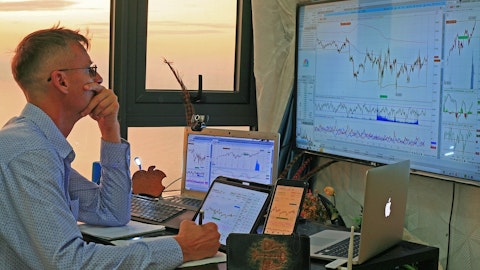Operator: Thank you. And our next question coming from the line of Robert Aguanno with Piper Sandler, Your line is open.
Robert Aguanno: Hey, guys. Thank you for taking the question. This is Robert on for Harsh Kumar here. You guys talked about a little bit on China customers and revenue decreasing and shifting over to Europe. Can you shed some more light on how you’re thinking about that geography and whether or not a bounce back or any sort of recovery matters in your forecast going forward? So any updates on that would be nice. Thank you.
Steve Daly: Thanks for the question. So we are definitely forecasting conservatively when it comes to growth within the China region. We today have facilities in four different cities. We have about 85 employees to 90 employees there that are focused on growing our telecom business, our data center business. There’s still a significant amount of hardware that’s supporting global networks that’s manufactured, designed and manufactured in China. So we will continue to have a strong presence and grow our presence to make sure that we’re gaining market share in that area. That said, we are definitely investing in other areas to strengthen up our overall global footprint and so we recognized a few years ago that we needed to strengthen our position within Europe.
That was one of the drivers for our acquisition and to open up a small fab and we now call that MACOM European Semiconductor Center and we want to build off of that. So in our minds, having a balanced portfolio of products, customers and geographic revenue is the goal, but to the extent that China continues to be a major player in the markets we’re in, we will continue to support them.
Robert Aguanno: Thank you, there. And just on the cost side, as well as my follow up, how should we be thinking about OpEx contribution as maybe revenues come back to more normalized levels following this inventory correction? I guess we’re in and around the 30% margin going before this. Any color on recovery there would be helpful as well.
Steve Daly: Sure, maybe I’ll say just a comment and then pass it to Jack for a more complete answer. I would just highlight that the team here at MACOM did a great job managing our total OpEx and if you compare our total OpEx from fiscal year ’22 to fiscal year ’23, it’s almost flat for total OpEx and so I think that’s a credit to the work that the finance organization, our operations, R&D, everybody has really stepped up to try to manage overall expenses and we will continue to carry this footing. Jack, do you want to add to that?
Jack Kober: Yeah, that’s helpful, Steve and we do take a very disciplined approach to our operating expenses. And a lot of those operating expenses are within our research and development area and as Steve had mentioned in his earlier response, making sure we’re getting returns from our investments in those R&D OpEx numbers that we’re spending is a critical area of focus for us, but along the way, we continue to make some structural type changes to our overall organization to continue to optimize it and that’s resulting in the stability we’ve seen in our operating expenses. And also with fiscal year ’23, we had two new acquisitions come online and we were able to absorb some of the additional operating expenses that came through those businesses by being disciplined with our base business.
So I think there’s still some leverage that we have. Obviously, as the top line grows, we will be adding some operating expenses. But I think we’ll be very disciplined as we were going back to fiscal years ’20 and ’21 and into ’22 when we were growing the top line and we were growing the operating expenses at a much lower rate than our revenue growth. So more of the same as we continue going into fiscal year ’24.
Operator: Thank you. And our next question coming from the line of Vivek Arya with Bank of America. Your line is open.
Lauren Guy: Hi, this is Lauren Guy on for Vivek. Thanks so much for taking my question. So I’ll just start with noting that inventory dollars seem to come down sequentially in the quarter. Could you just speak a little bit on how you’re managing inventory and utilization during the downturn? And if you can give any comments segment specific on how inventory is looking, that’d be great. Thank you.
Steve Daly: Yeah, no problem, Laurie. With regard to inventory, we were pleased with some of the reduction that we had seen here in the current quarter. Things continue to be challenged. We are careful in terms of where we invest our inventory dollars as well. We had noted this a couple of quarters back where we did see a bit of an uptick in our inventory, and some of that was to support some of the orders and backlog that we had coming through. So it’s a careful balance as we work our way through the cycles here in terms of maintaining the appropriate levels of inventory to support our customer needs, but we’ve got a number of different metrics that we look to across the business that we’re working to try and manage and I’ll also add that we did have the two acquisitions that had come to us over the past fiscal year.




